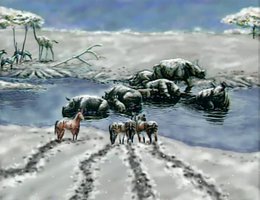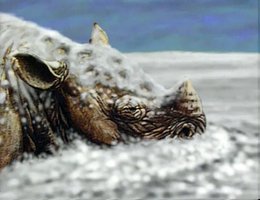

Twelve million years ago, what became Ashfall was a watering hole in the middle of a savanna — a flat, warm and humid grassland much like some areas of Africa today. The animals would gather here to drink. Hunters would prey on smaller species, sick or young animals. More than 40 species of plants and animals were common visitors or residents.

All of that changed one day. Hundreds of miles to the west, in what is now Idaho, a huge volcano erupted. Scientists now estimate that this eruption was at least 100 times greater than the recent Mount St. Helens eruption. The volcanic ash from the ancient eruption was carried by the winds across the plains and eventually deposited approximately one foot of volcanic ash dust over much of northern Nebraska. The volcanic ash began to blow around like fresh snow. Eventually the high ground was blown free of ash, but low-lying areas, like the watering hole at Ashfall, were filled to depths of eight feet or more. The scene has been described as a gray blizzard.
When this ash is examined under a microscope, it is seen to be made up of millions of sharp, jagged particles of rock and glass. The animals around the watering hole could not help but breathe in these rough particles. Birds and turtles were the first species to die as their lungs filled up with sediment. Musk deer and small carnivores were the next to die. The larger animals were also having trouble breathing. Inside their bodies, their bones were growing abnormal patches of highly porous new bone mater, especially around the lower jaw and on the shafts of major limbs and the ribs. This is evidence that they were not getting enough oxygen. Over the period of a few days to a few weeks, horses and camels began to die, and scavengers would circle in, gnawing the flesh down to the bone.
Finally, even the largest animals had to return to the pond to drink. A herd of nearly 100 rhinos must have shuffled through the clouds of blowing ash to get to the pond. Some mothers had baby rhinos by their sides. But the ash became too much for even these large animals. Some of the mothers died. Their young still tried to nurse, and then they died as well.
Gradually, more ash drifted in on the wind, and the entire death scene was buried. Probably because of the danger that the ash presented to later scavengers, the site remained relatively untouched for the next twelve million years.